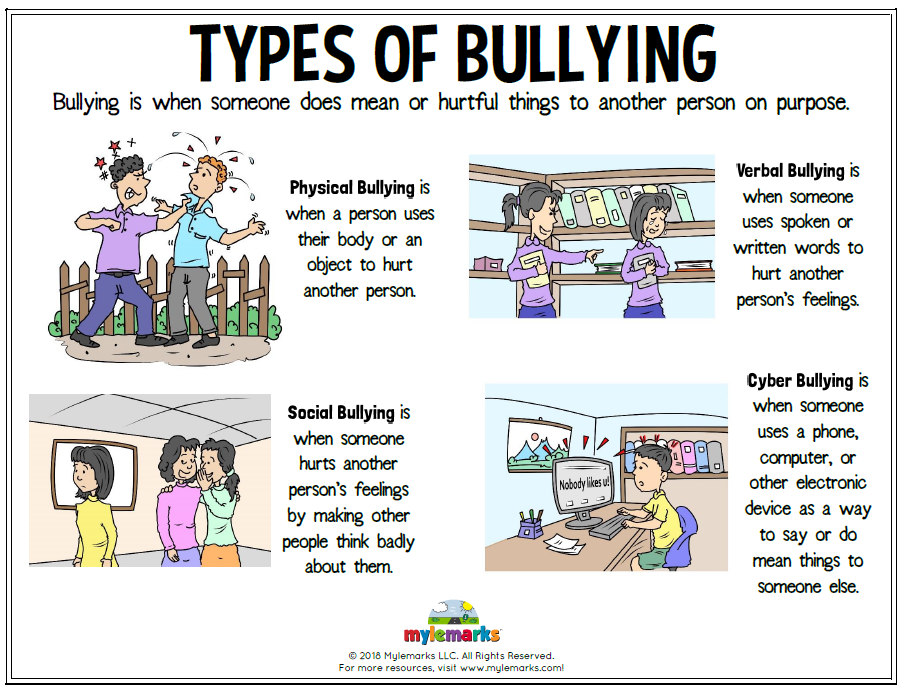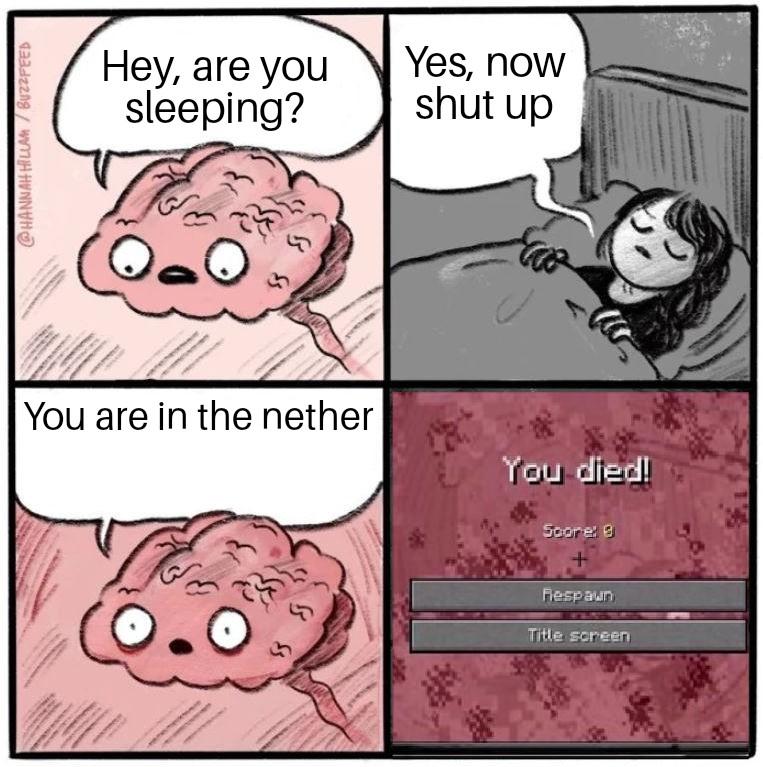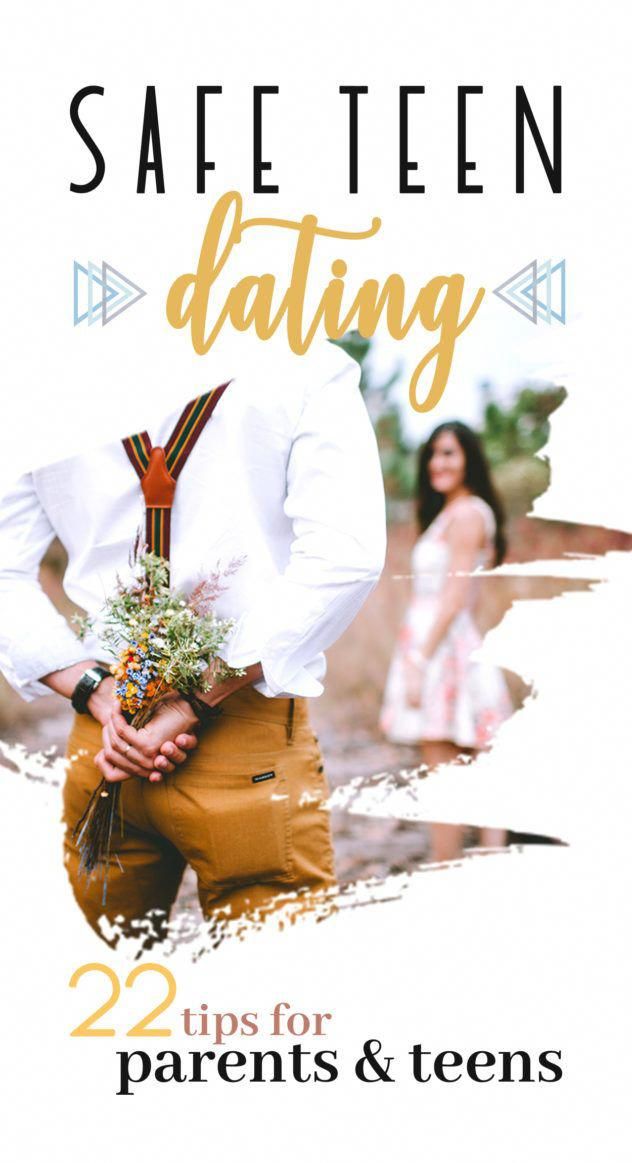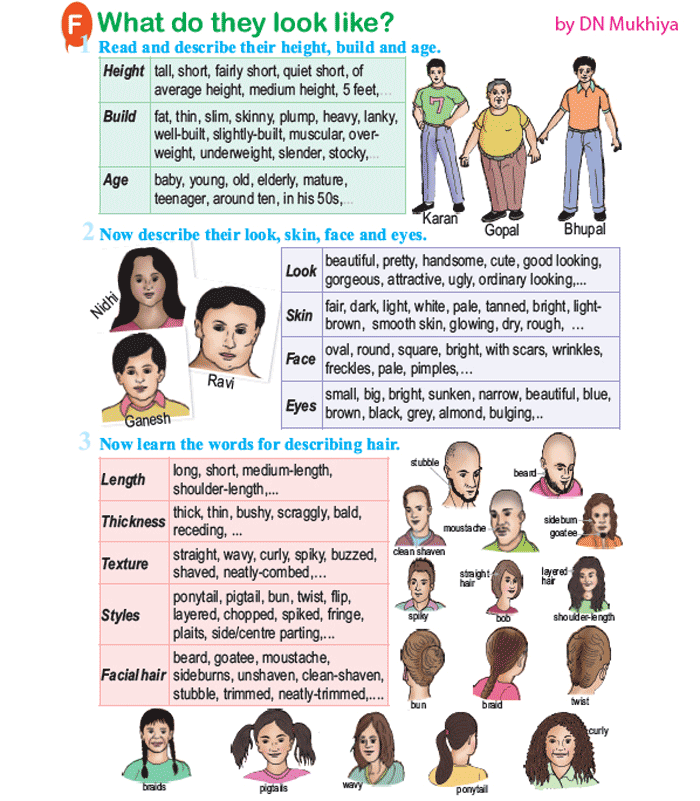Three types of bullying
Can You Name The Three Types of Bullying?
There are Three Types of Bullying
Bullying occurs when a person (not just children)…(or this can be a group of people) repeatedly tries to physically hurt, emotionally embarrass or frighten another person.
The Mental Health Humor Cartoon above is focused on bullying on school grounds and finding a loop-hole in the Anti-Bullying Policy. Much of the bullying that happens nowadays is not always on “school grounds” or in the real world… Online there is vicious and hateful bullying being done. This is called Cyberbullying or electronically bullied.
“Children and teenagers who bully use their unequal power against kids or teens who are younger or unable to fight back in any meaningful way. This imbalance of power is key, because bullies look for victims who cannot defend themselves. While sometimes the bullying is physical, increasingly bullying behavior is done electronically online, through apps, Facebook, other social media, or websites.
This form of bullying is referred to as electronically bullied.” ~Facts & Statistics on BullyingBy John M. Grohol, Psy.D.
There are Three Types of Bullying
According to the U.S. Department of Health & Human Services website Stopbullying.gov, defines 3 types of bullying: Verbal bullying, Social bullying (also called relational), and Physical bullying .
Here are the three types of bullying:
Verbal bullying is saying or writing mean things. Verbal bullying includes:
- Teasing
- Name-calling
- Inappropriate sexual comments
- Taunting
- Threatening to cause harm
Social bullying, sometimes referred to as relational bullying, involves hurting someones reputation or relationships. Social bullying includes:
- Leaving someone out on purpose
- Telling other children not to be friends with someone
- Spreading rumors about someone
- Embarrassing someone in public
Physical bullying involves hurting a persons body or possessions.
Physical bullying includes:
- Hitting/kicking/pinching
- Spitting
- Tripping/pushing
- Taking or breaking someones things
- Making mean or rude hand gestures
http://blogs.psychcentral.com/humor/2016/05/can-bullies-change/
Reference Grohol, J. (2016). Facts & Statistics on Bullying. Psych Central. Retrieved on May 27, 2016, from http://psychcentral.com/lib/facts-statistics-on-bullying/
Stop Bullying Gov (2016). Bullying Definition. stopbullying.gov. Retrieved on May 27, 2016, fromhttp://www.stopbullying.gov/what-is-bullying/definition/index.html
Types Of Bullying | National Centre Against Bullying
Share this:
There are many different types of bullying that can be experienced by children and adults alike, some are obvious to spot while others can be more subtle.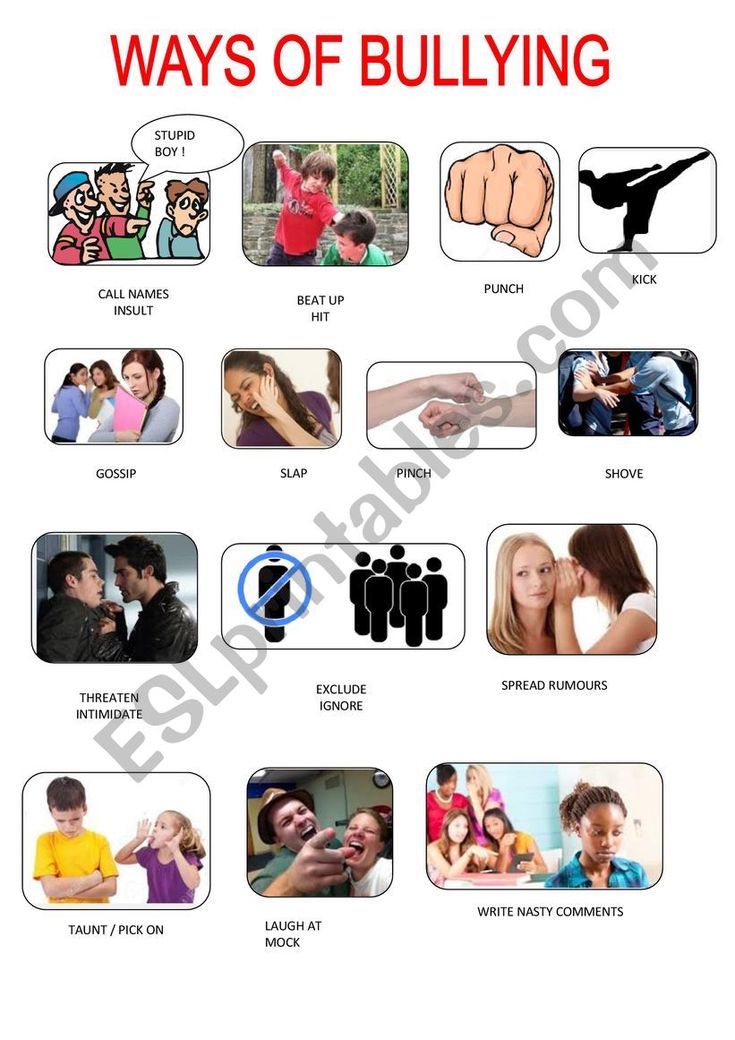 The different types of bullying that we look at below are some of the ways that bullying could be happening.
The different types of bullying that we look at below are some of the ways that bullying could be happening.
Physical bullying
Physical bullying includes hitting, kicking, tripping, pinching and pushing or damaging property. Physical bullying causes both short term and long term damage.
Verbal bullying
Verbal bulling includes name calling, insults, teasing, intimidation, homophobic or racist remarks, or verbal abuse. While verbal bullying can start off harmless, it can escalate to levels which start affecting the individual target.
Social bullying
Social bullying, sometimes referred to as covert bullying, is often harder to recognise and can be carried out behind the bullied person’s back. It is designed to harm someone’s social reputation and / or cause humiliation.
Social bullying can include:
- lying and spreading rumours
- negative facial or physical gestures, menacing or contemptuous looks
- playing nasty jokes to embarrass and humiliate
- mimicking unkindly
- encouraging others to social exclude someone
- damaging someone’s social reputation or social acceptance.
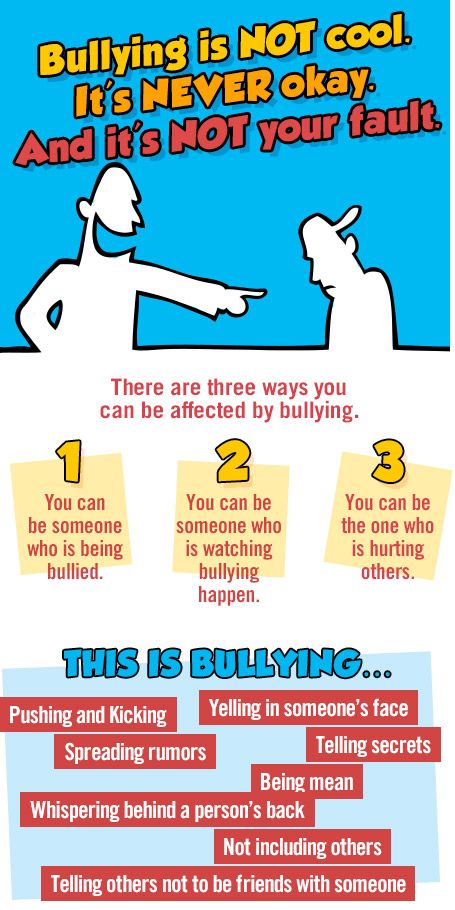
Cyber bullying
The Cyber Bullying Research Centre defines cyber bullying as: Intentional and repeated harm inflicted through the use of computers, phones, and other electronic devices.
Cyber bullying can be overt or covert bullying behaviours using digital technologies including hardware such as computers and smartphones, and software such as social media, instant messaging, texts, websites and other online platforms.
Cyber bullying can happen at any time. It can be in public or in private and sometimes only known to the target and the person bullying.
Cyber bullying can include:
- abusive or hurtful texts, emails or posts, images or videos
- deliberately excluding others online
- nasty gossip or rumours
- imitating others online or using their log-in.
You may also be interested in
-
Definition of bullying
While the definition of bullying is broad and can occur in a variety of environments, it usually is a relationship problem and requires relationship-based solutions.
Read More >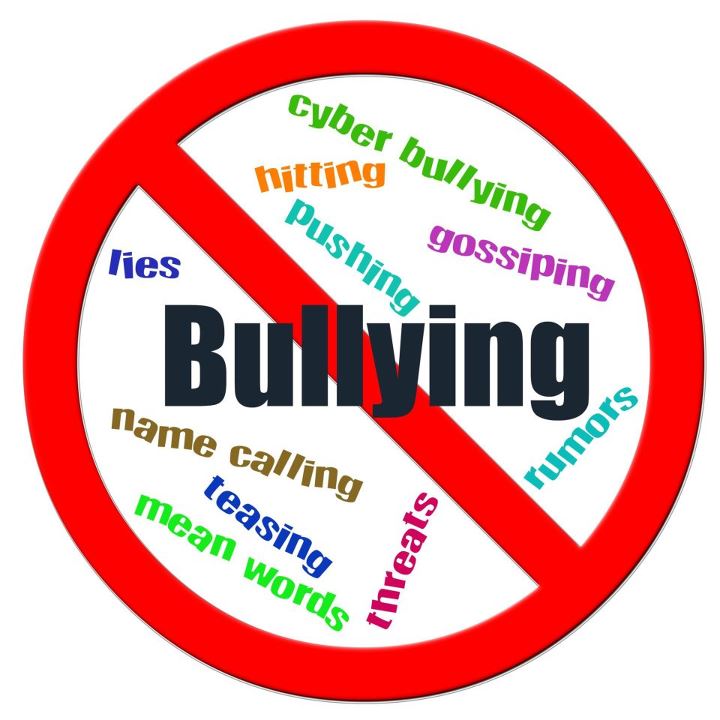
-
Signs of bullying
Spot the different signs of bullying and some of the symptoms.
Read More > -
How to stop bullying
You may have noticed your child is showing signs of being bullied.
Read More >
Subscribe to the Alannah & Madeline Foundation newsletter
Subscribe to the Alannah & Madeline Foundation newsletter or visit our media centre for information including media releases, spokespeople, publications and contacts.
Main types of school bullying (bullying) - Child development
Bullying (bullying, harassment, intimidation) is arrogant, offensive behavior associated with an imbalance of power, authority or power. Bullying comes in many forms - there are verbal, physical, social forms of bullying, as well as cyberbullying.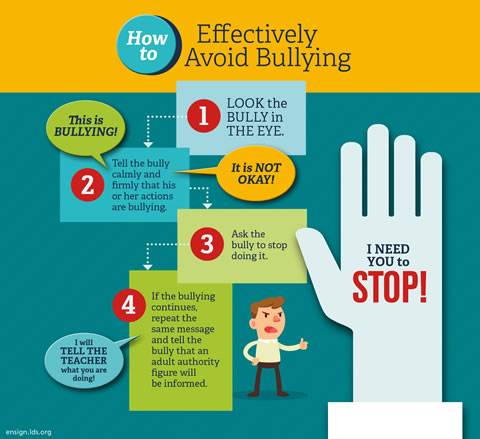 While schools do a lot to prevent and deal with bullying in a timely manner, parents are still the best at teaching children how to prevent and stop bullying. The following are tips on how to deal with the four most common types of bullying. nineWhat is it? religion, ethnicity, disability, clothing style, etc.).
While schools do a lot to prevent and deal with bullying in a timely manner, parents are still the best at teaching children how to prevent and stop bullying. The following are tips on how to deal with the four most common types of bullying. nineWhat is it? religion, ethnicity, disability, clothing style, etc.).
Things to do: First, teach your children to be respectful. Use your own behavior patterns to reinforce the idea that everyone deserves to be treated well—thank teachers, praise friends, be kind to store employees. Develop children's self-esteem and teach them to appreciate their strengths. The best defense a parent can offer is to strengthen their child's self-esteem and independence and their willingness to take action if needed. Discuss and practice safe, constructive ways for your child to respond to the bully's words and actions. Together, come up with basic phrases that the child can say to his abuser in a firm but not hostile tone, such as: “Your words are unpleasant,” “Leave me alone,” or “Leave me alone.” nine0003
The best defense a parent can offer is to strengthen their child's self-esteem and independence and their willingness to take action if needed. Discuss and practice safe, constructive ways for your child to respond to the bully's words and actions. Together, come up with basic phrases that the child can say to his abuser in a firm but not hostile tone, such as: “Your words are unpleasant,” “Leave me alone,” or “Leave me alone.” nine0003
2. Physical bullying
- What it is: physical intimidation or bullying through aggressive physical intimidation consists of repeatedly hitting, kicking, tripping, blocking, pushing, and touching in an unwanted and inappropriate manner.
- Example: a child is pulled down in public in the playground.
- Signs: when this happens, many children do not tell their parents about the incident, so watch out for possible warning signs and indirect signs such as unexplained cuts, scratches, bruises, bruises, missing or torn clothing, frequent head complaints.
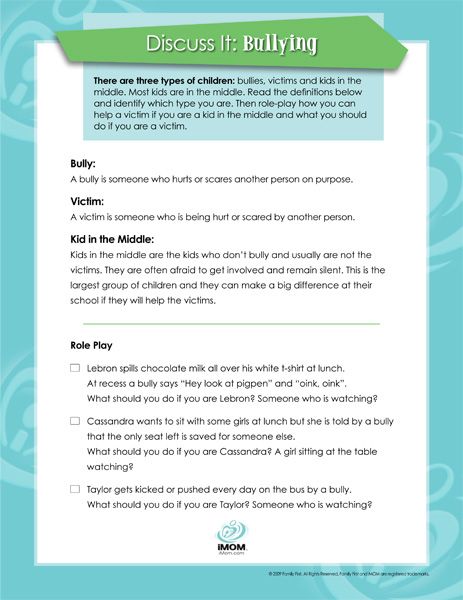 pain and pain in the abdomen. nine0012
pain and pain in the abdomen. nine0012
Things to do: If you suspect your child is being physically abused, start a casual conversation - ask about school, what happened during lunch or recess, on your way home. Based on the responses, ask the child if anyone has been abusive towards them. Try to contain your emotions. Emphasize the importance of an open, ongoing connection between your child and you, the teachers, or the school psychologist. Document the dates and times of bullying incidents, the corresponding reactions of those involved, and the actions that were taken. Do not contact the bully(s)'s parents to resolve the problem yourself. If your child continues to be physically abused and you need more help outside of school, contact local law enforcement. There are anti-bullying and harassment laws that require prompt corrective action. nine0003
3. Social bullying
- What it is: Social bullying or isolation bullying involves someone being intentionally excluded from participating in group activities, whether it be a meal at the dinner table, a game, an activity.
 sports or community activities.
sports or community activities. - Example: a group of girls in a dance class are discussing a weekend party and exchanging pictures, without paying any attention to one girl whom the children decided not to invite, pretending that she does not exist. nine0012
- Characteristics: Watch for changes in your child's mood, his unwillingness to maintain participation in the company of peers, and a greater than usual desire for solitude. Girls are more likely than boys to experience social isolation, non-verbal or emotional bullying. The emotional pain from this type of bullying can be as intense as physical abuse and last much longer.
Things to do: Use the evening to talk to the children about how their day went. Help them look for the positive in everything, pay attention to the good qualities of children and make sure they know that there are people who love them and are always ready to take care of them.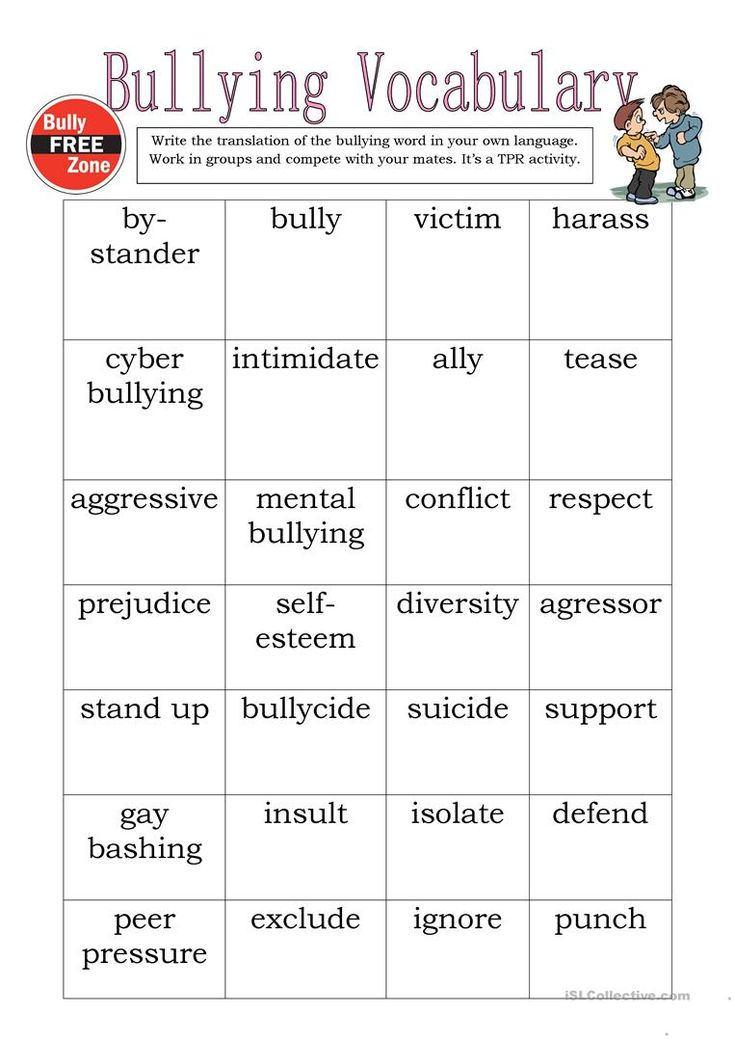 Focus on developing their talents and interests in music, art, sports, reading, and extracurricular activities so your children can build relationships outside of school. nineWhat is it? . Sexist, racist, and similar messages create a hostile environment, even if they are not directed directly at the child.
Focus on developing their talents and interests in music, art, sports, reading, and extracurricular activities so your children can build relationships outside of school. nineWhat is it? . Sexist, racist, and similar messages create a hostile environment, even if they are not directed directly at the child.
Things to do: Offensive messages can spread anonymously and quickly, resulting in 24/7 cyberbullying, so set your home internet rules first.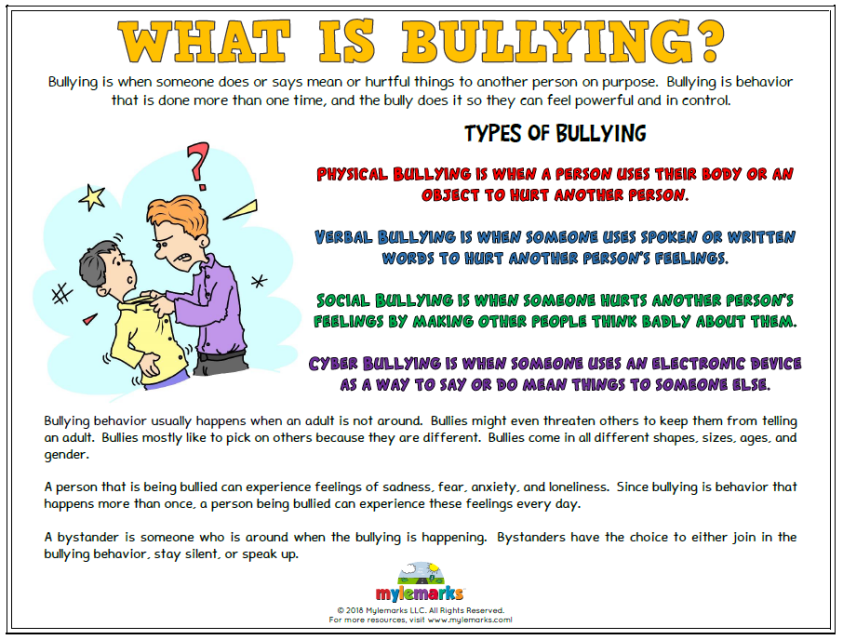 Agree with your child about age-appropriate time limits. Be aware of popular and potentially offensive sites, apps, and digital devices before your child starts using them. Let your child know that you intend to track their online activity. Tell him that if he is being cyberbullied, he must not engage in, react to, or provoke the bully. Instead, he needs to report the cyberbullying to you so that you can print the provocative messages, including the dates and times they were received. Report cyberbullying to the school and ISP. If cyberbullying escalates and contains threats and sexually explicit messages, contact local law enforcement. nine0003
Agree with your child about age-appropriate time limits. Be aware of popular and potentially offensive sites, apps, and digital devices before your child starts using them. Let your child know that you intend to track their online activity. Tell him that if he is being cyberbullied, he must not engage in, react to, or provoke the bully. Instead, he needs to report the cyberbullying to you so that you can print the provocative messages, including the dates and times they were received. Report cyberbullying to the school and ISP. If cyberbullying escalates and contains threats and sexually explicit messages, contact local law enforcement. nine0003
If a child tells you that he or someone else is being bullied, support him, praise the child for having the courage to tell you about it, and gather information (do not get angry and blame the child himself). Emphasize the difference between snitching just to get someone in trouble and having a frank conversation with an adult who can help.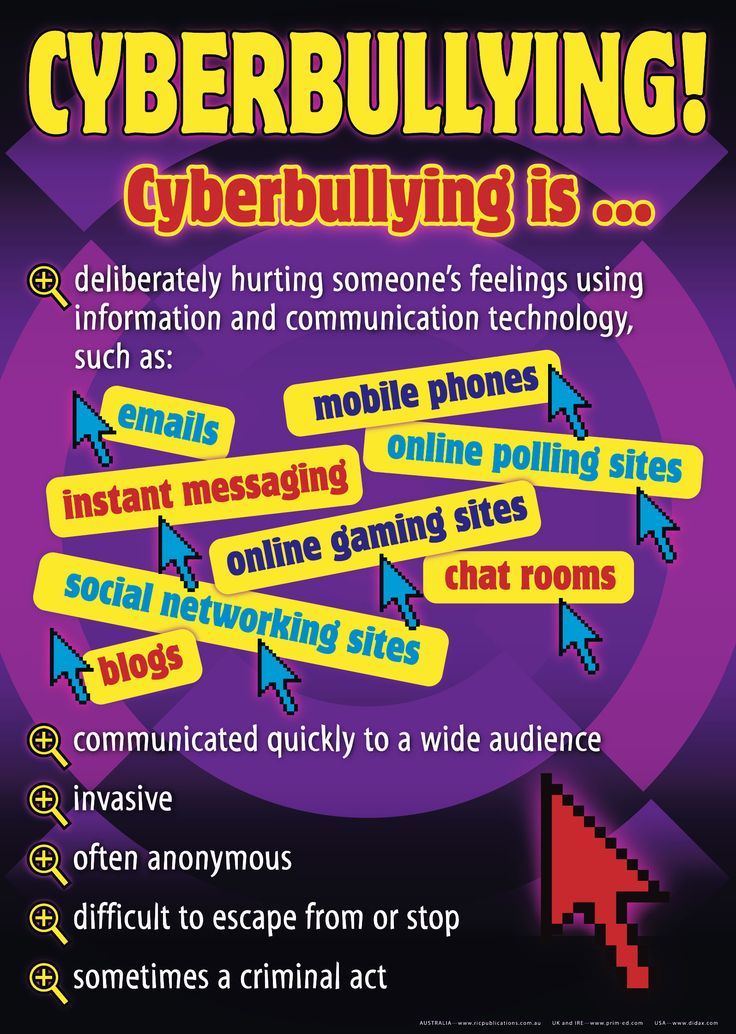 Always take action against bullying, especially if the abuse is severe or persistent, contact your child's teacher or principal to monitor the situation until it stops. nine0003
Always take action against bullying, especially if the abuse is severe or persistent, contact your child's teacher or principal to monitor the situation until it stops. nine0003
Three types of bullying. Bullying. How to End Violence and Create a Society with More Kindness
All four methods of bullying - one-time, constant multiple, bullying and cyber-bullying - can be vertical (the victim is higher or lower in status than the aggressor) or horizontal (the aggressor and the victim are equal in status). If a child is humiliated by a teacher or one of the parents or older brothers/sisters, this is vertical bullying. A group of peers who bully a friend is bullying horizontally. The teacher and students who turn against a classmate are involved in both horizontal and vertical bullying: an extremely devastating combination for the victim. nine0003
There are three types of participation in these four ways of bullying: verbal, physical and behavioral (aka social). Each option in itself is capable of causing tremendous harm, but the aggressors often combine them - to be sure .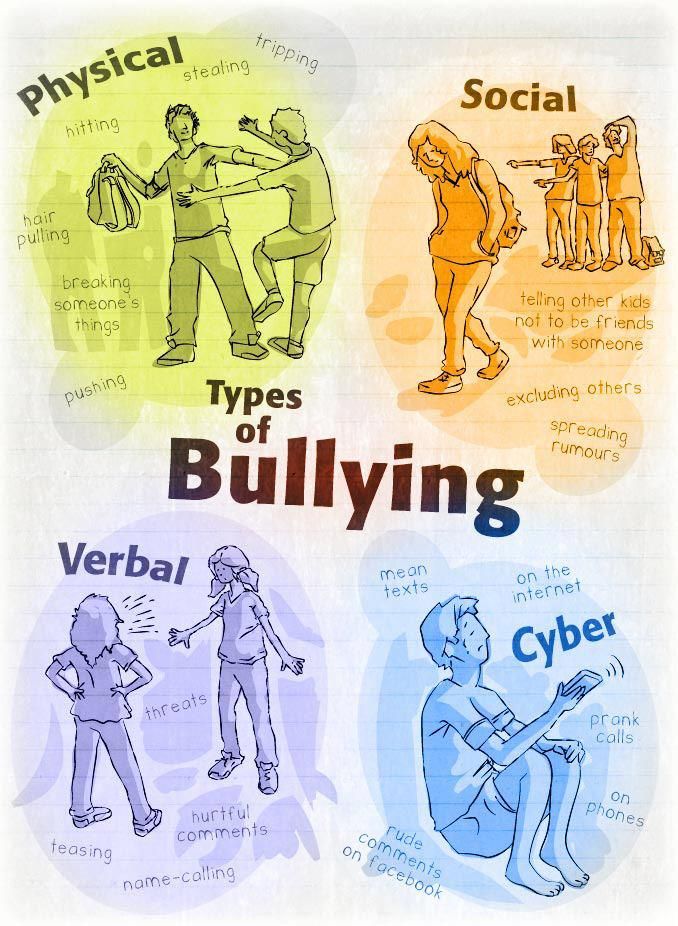 .. Both boys and girls participate in verbal bullying. Boys are more likely to resort to physical, girls are more likely to resort to behavioral. This is due to the unequal social roles of men and women characteristic of our culture, and not the difference in physical parameters.
.. Both boys and girls participate in verbal bullying. Boys are more likely to resort to physical, girls are more likely to resort to behavioral. This is due to the unequal social roles of men and women characteristic of our culture, and not the difference in physical parameters.
Physical bullying is not exclusively the prerogative of boys. Large girls can also shove and push smaller peers of both sexes, mocking them.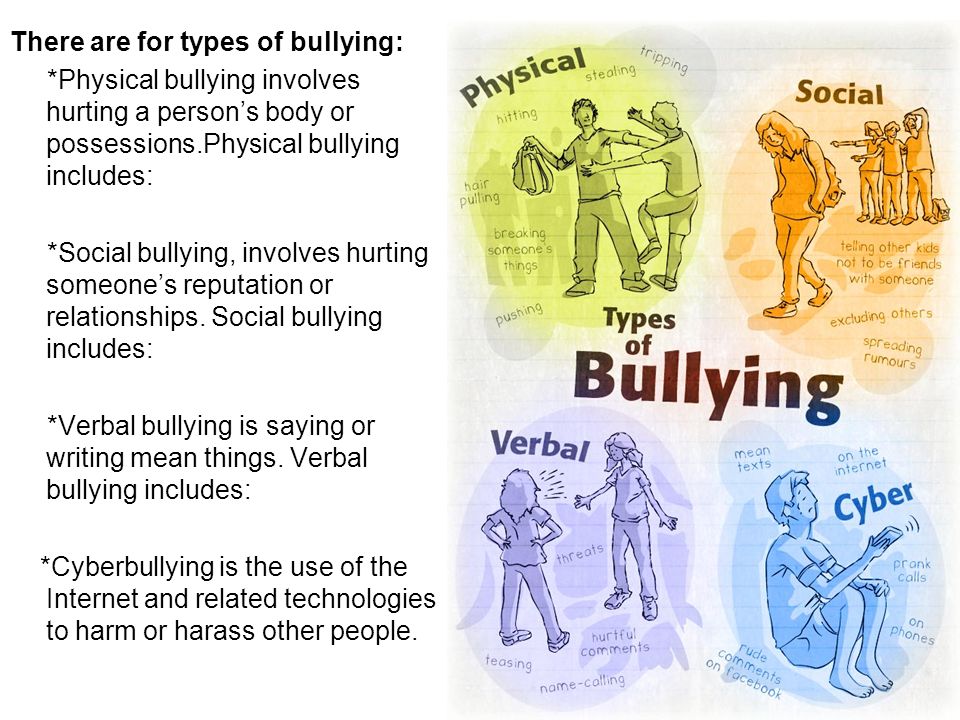 Still, the main type of bullying among girls is behavioral. At the same time, they usually unite in small, closer communities with clear external boundaries. Accordingly, by excluding a girl from such a social circle, the comrades are already causing her considerable suffering.
Still, the main type of bullying among girls is behavioral. At the same time, they usually unite in small, closer communities with clear external boundaries. Accordingly, by excluding a girl from such a social circle, the comrades are already causing her considerable suffering.
Verbal bullying
“Even though you call it a pot, just don’t put it in the oven”, “Swearing doesn’t hang on the collar” - are these proverbs really true? Evil words are powerful weapons, they can break the child they are aimed at. nine0003
So, the most common form of bullying is verbal abuse. Both boys and girls use them. Aggressors often justify their behavior by stating, "It's just a joke!" or “We didn’t mean to offend anyone!” According to statistics, verbal bullying accounts for 70% of cases of bullying. It is not easy to catch the offender in such bullying: it is possible to whisper evil words even in the presence of adults - no one but the victim will hear. And on the playground, on the contrary, you can yell nasty things at the top of your voice - go and make out in the general noise and uproar who exactly did it, and adults usually tend to regard all this as something insignificant. For the aggressor, bullying is quick and safe, but for the victim, it can be extremely painful. The most receptive to words are young children with a not yet fully formed understanding of their own "I", although repeated insults can eventually break even those who already have a well-developed self-defense system. nine0003
For the aggressor, bullying is quick and safe, but for the victim, it can be extremely painful. The most receptive to words are young children with a not yet fully formed understanding of their own "I", although repeated insults can eventually break even those who already have a well-developed self-defense system. nine0003
A 14-year-old teenager from Surrey (British Columbia, Canada) who committed suicide left a suicide letter in which four out of five pages were occupied by a list of humiliating nicknames and insults he received from classmates (most often the boy was called “four-eyed”, “shnobel ", "geek" and "faggot"). And a girl, his age, wounded her friend with a pistol, allegedly turning away from her and joining the tormentors, who called her an idiot, stupid, fat and terrible ...
Another 14-year-old, this time from Buffalo, New York, was verbally bullied online and eye to eye for several years in a row: “You fag”, “Die! We don't care! Nobody will cry. Everyone will be very happy. " This boy also committed suicide...
" This boy also committed suicide...
If adults in a given community consider verbal bullying to be permissible, or at least not punishable, it becomes the norm. Thus, the dehumanization of the victims is reinforced. It is easier to attack a dehumanized, impersonal person - he does not arouse compassion in those around him. When a child is constantly ridiculed, he is often excluded from social activities, that is, he is the last to be called anywhere, and the first to be driven from everywhere. Who needs a loser? nine0003
Verbal bullying is name-calling, ridicule, belittling, harsh, malicious criticism, slander, racist insults, obscene or sexually derogatory language. It can also be accompanied by extortion (of, say, pocket money or items), phone threats, threatening emails, rude messages, obscene comments on social media, anonymous letters containing threats of violence, and slanderous gossip. Yes, gossip is also a form of bullying. Hesiod is also the first historically reliable ancient Greek poet who lived in the 8th century BC.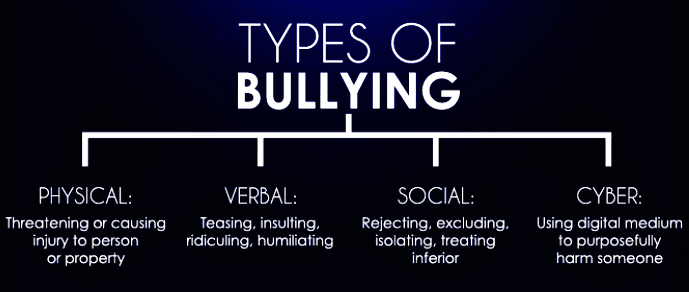 e., said that gossip is insidious, lightweight, spreads quickly, but it is difficult to bear it and it is difficult to get rid of it. Gossip devalues human relationships and publicizes the problems of a bullied child. nine0003
e., said that gossip is insidious, lightweight, spreads quickly, but it is difficult to bear it and it is difficult to get rid of it. Gossip devalues human relationships and publicizes the problems of a bullied child. nine0003
Physical bullying
Physical bullying is the most obvious type of bullying. It's hard not to notice, although children themselves report physical bullying in less than 30% of cases. It is rarely the first resort resorted to by aggressors. First, verbal and/or behavioral bullying is usually used, and then, seeing that they get away with insults, they move on to physical abuse. The older and stronger the aggressor, the more dangerous the situation, even if serious harm is not his intention: “I just wanted to scare him. I didn't mean to break his arm!" nine0003
Most often, physical harassment is expressed in slaps, kicks, punches and kicks, strangulation, but is not limited to them. Aggressors can bite, pinch, scratch the victim, twist her arms, and also spoil her clothes and property.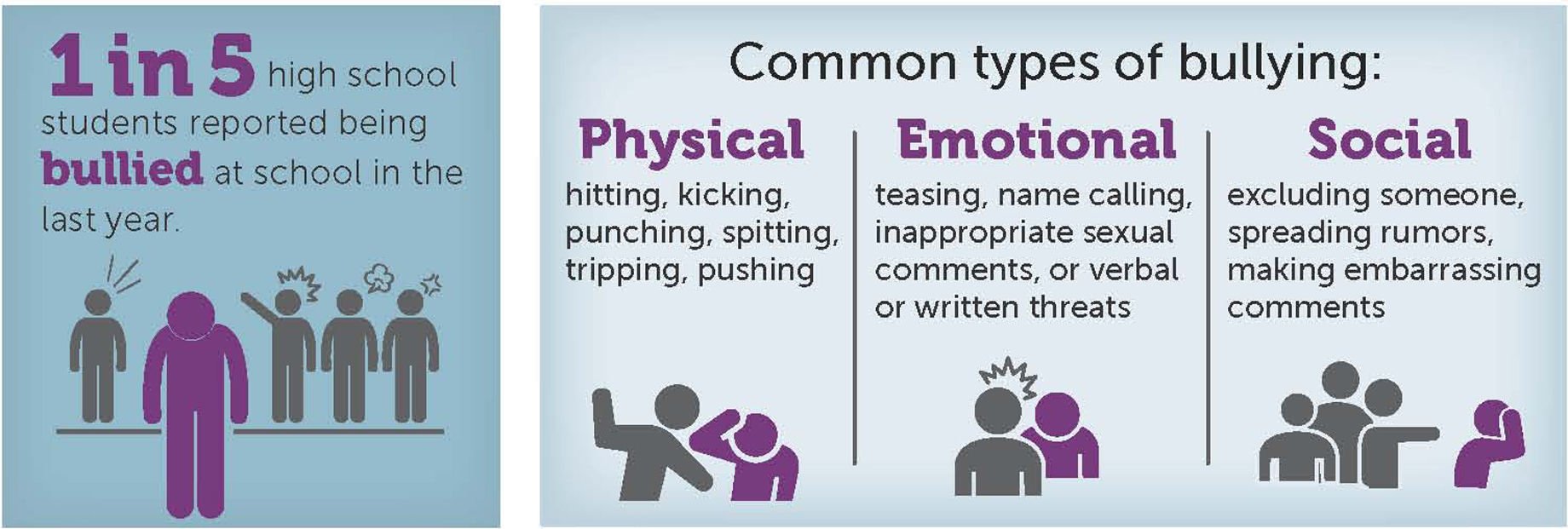 Unfortunately, in the arsenal of physical harassment there are tools for torture, and even weapons ...
Unfortunately, in the arsenal of physical harassment there are tools for torture, and even weapons ...
In 2012, CNN reported that in Daegu, South Korea, a 13-year-old boy jumped out of the seventh floor window of his house. He left a note in which he described in detail how classmates beat him with sticks and beat him, wearing boxing gloves, took things and money, burned them with lighters and tied an electric wire around his neck like a leash. Another boy wrote that physical bullying was preceded by years of verbal bullying and humiliation. nine0003
Korean specialists identify three main types of this kind of influence on a person: 1) coercion to do something that a person does not want, extortion, threats, insults; 2) ostracism and isolation; 3) physical or sexual abuse. Lim Seng Min drank all three bitter cups. Notice what he said about the long years of verbal bullying, extortion and humiliation before the aggressors turned to physical torture. This is the usual path - from verbal bullying to behavioral, and then to physical.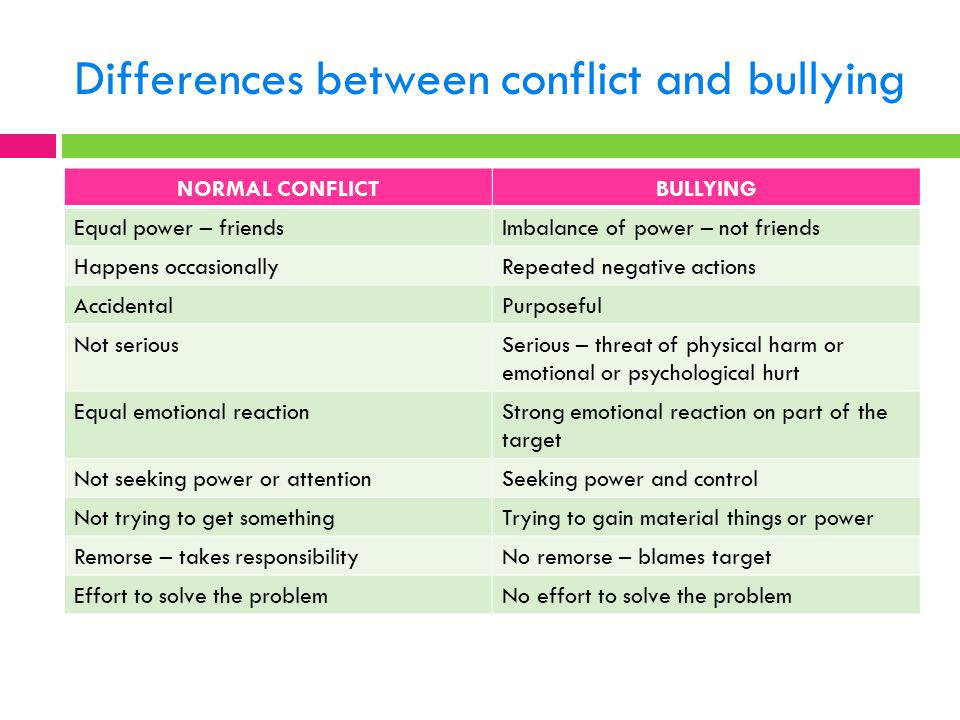 If a child has been physically bullied, it is almost always safe to say that they have already experienced verbal and/or behavioral bullying. nine0003
If a child has been physically bullied, it is almost always safe to say that they have already experienced verbal and/or behavioral bullying. nine0003
Aggressors who use physical violence to bully their peers are often a source of constant headache for teachers and parents, but most often they themselves experience considerable problems. Nevertheless, they have every chance to turn into violent criminals over time.
Outside the schoolyard
I will allow myself a small digression here, I will ask a question, who is in the zone of special professional risk, and I will answer it. nine0003 There are two spheres of human activity in which there is a decrease in the already low level of horizontal physical violence (between status equals) and a significant increase in vertical violence (between status unequals) - these are education and medicine. Pedagogical and medical workers, of course, are not guaranteed against horizontal and vertical verbal bullying and behavioral bullying, but most of all, according to them, they are worried - and frightened! - physical abuse from those they are trying to help: students and patients. ...On the same day that several teenage girls from Carson City, Nevada, were arrested for inviting other high school students to join them on Facebook for "Attack - Teacher's Day!", in Omaha, Nebraska, a 17-year-old youth killed the head teacher, seriously wounded his assistant, and then shot himself. The girls studied well, and some were recognized leaders at school. In other words, these aggressors had a high social status. The guy, on the contrary, was expelled from school shortly before the tragedy. nine0003 The topic of violence against medical personnel in the workplace was raised in her article “Confronting violence is not my professional competence” (2011) by Laura A. Stokowski, a surgical nurse. The reason was - 48% of the total number of minor injuries received by employees of health and social care institutions, they are inflicted by patients. The article gives reasons why staff often do not report it: “Nurses are afraid that if they report such facts, it will affect patient reviews and lower the rating of the hospital, for which the administration will definitely not praise them. Students who are bullied and are afraid to talk about it have similar fears. Despite the fact that most American schools today have a confidential and secure system for receiving complaints from students, they, like nurses, are almost always limited to verbal complaints, and it is rarely the case that the first person contacted by students is school administrators. . Behavioral (social) bullying For those who are outside the team or group, behavioral bullying is more difficult to notice than any other. Back in the 18th century, William Hazlitt, a philosopher and one of the classics of English essayism, said: “Slander does not need confirmation. Vicious accusations, thrown in passing, will tarnish anyone so that you won’t wash off even after their refutation. To create a bad impression about someone, it is not necessary that what is said about him be true. It's important that it be said." With social media bullying, rumors can spread endlessly, be constantly fed and cause great harm, and it is not easy to trace their source. Behavioral bullying can be used to alienate and reject someone, or to intentionally destroy friendships. It sometimes includes nasty looks, eye rolls, heavy sighs, frowns, grins and sneers, actions that are hard to blame. Behavioral bullying is most active in high school, when puberty begins, accompanied by physical and emotional changes in the body. Defiantly not inviting a peer to a common event or birthday party or excluding him from the game is bullying. Yes, it, unlike name-calling, as well as a punch, is implicit. Its results are not as obvious as a black eye and a torn jacket ... Children hide pain from her, and if they talk about it, adults often dismiss their complaints as something insignificant (“You yourself would not want to go to their party!"). nine0003 In 1992, Vivian G. Paley, who worked for many years in a kindergarten and elementary school at the University of Chicago experimental school, realized that despite the prohibition on calling and hitting other children, some of her charges dictate their own rules, purposefully excluding other children from communication, introduced the rule: “We don’t say“ we don’t play with you ””. nine0003
nine0003 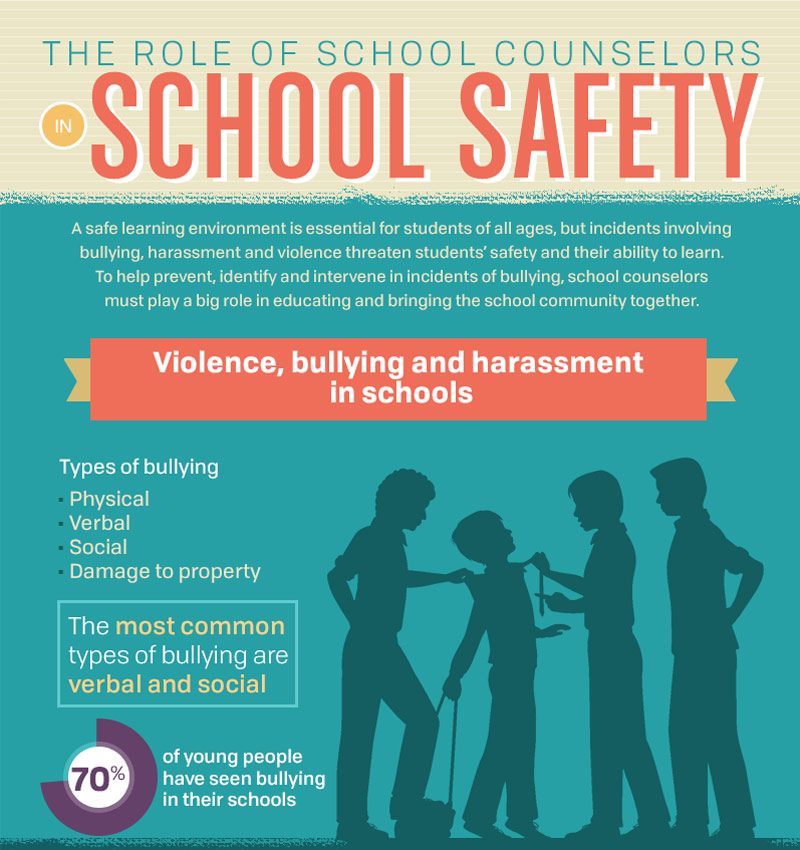 Some are unaware of the hospital's policy regarding such complaints, or feel that they should only talk about it when there is an injury. There are those who fear that the administration will doubt their competence, consider that the nurse herself provoked the patient, and she will be labeled a brawler, especially in the absence of obvious physical injuries. If nurses report incidents of violence, 85% confine themselves to a verbal complaint.” nine0003
Some are unaware of the hospital's policy regarding such complaints, or feel that they should only talk about it when there is an injury. There are those who fear that the administration will doubt their competence, consider that the nurse herself provoked the patient, and she will be labeled a brawler, especially in the absence of obvious physical injuries. If nurses report incidents of violence, 85% confine themselves to a verbal complaint.” nine0003 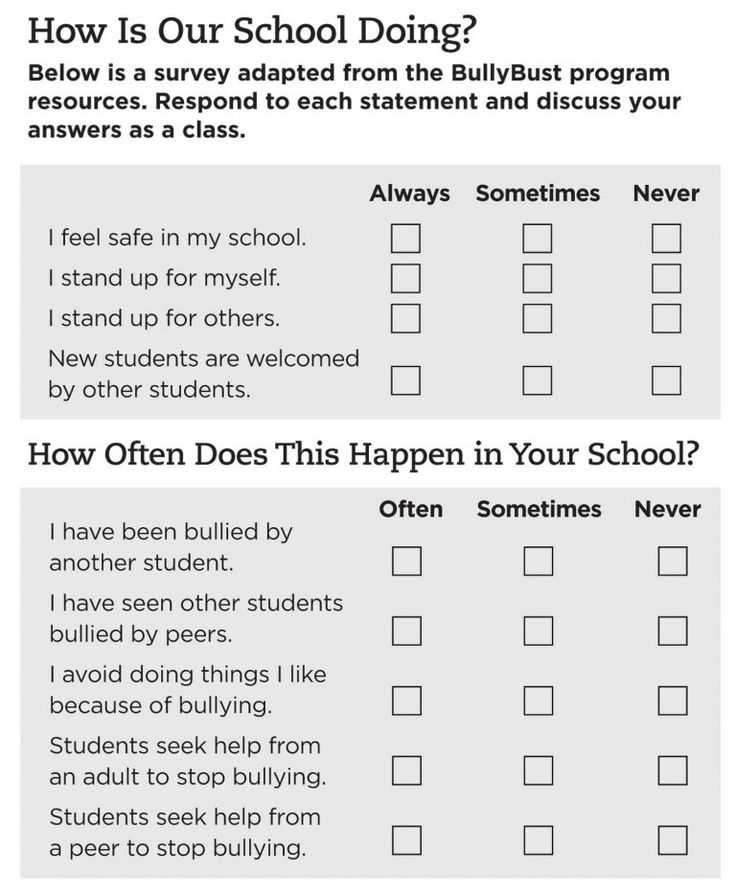 Behavioral bullying is the systematic degradation of the victim's self-esteem. To do this, she is ignored, left alone, excluded from common activities and avoided. The latter, by the way, combined with gossip, is a powerful weapon of harassment. Both are done as if by chance. It is difficult to identify this. The victim may not even know that rumors are spreading about her, but she suffers from their consequences. (“Stay away from him, he has lice,” “Don’t talk to her, she slept with half the basketball team. Everyone will think you’re just as approachable.”)
Behavioral bullying is the systematic degradation of the victim's self-esteem. To do this, she is ignored, left alone, excluded from common activities and avoided. The latter, by the way, combined with gossip, is a powerful weapon of harassment. Both are done as if by chance. It is difficult to identify this. The victim may not even know that rumors are spreading about her, but she suffers from their consequences. (“Stay away from him, he has lice,” “Don’t talk to her, she slept with half the basketball team. Everyone will think you’re just as approachable.”) 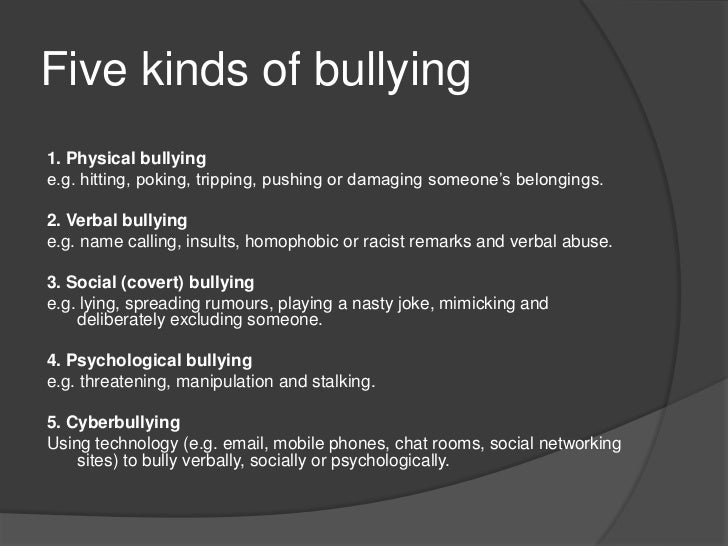 No amount of apology after that will eliminate the gossip from the virtual space and will not correct the entrenched bad impression. nine0003
No amount of apology after that will eliminate the gossip from the virtual space and will not correct the entrenched bad impression. nine0003 